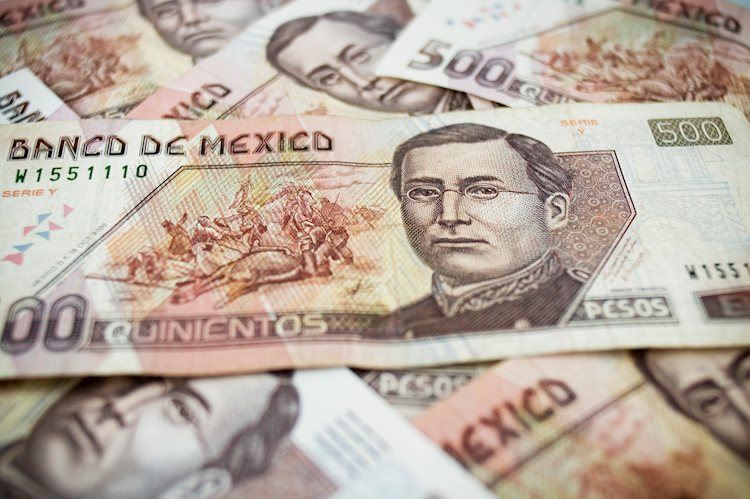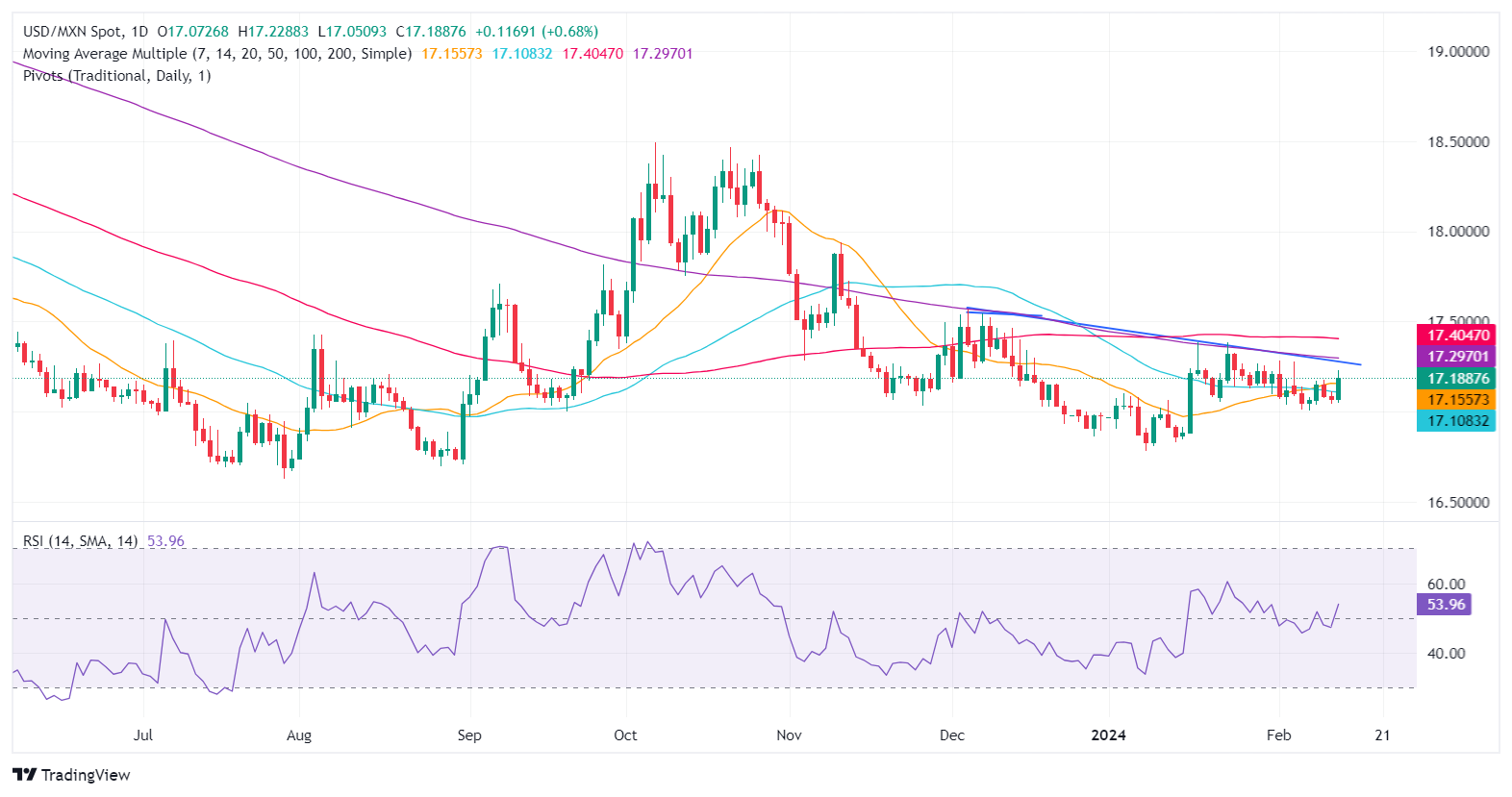- Mexican Peso tumbles as US CPI data exceeds forecasts, boosting the US Dollar.
- Unexpectedly high US inflation in January shifts market outlook, questioning the Fed’s upcoming interest rate decisions.
- Mexico’s economic calendar is light on Tuesday with attention turning to next week’s Retail Sales, GDP and inflation reports.
- Banxico’s Rodriguez Ceja emphasizes ongoing disinflationary measures in Mexico, aiming to manage inflation effectively.
The Mexican Peso plunged against the US Dollar during Tuesday’s North American session following a red-hot inflation report from the United States. The data caught traders off guard as they were eyeing an acceleration of the disinflation process. They had predicted that the Federal Reserve (Fed) wouldn’t need to keep rates “higher for longer,” but that narrative has returned to the limelight. At the time of writing, the USD/MXN exchanges hands at 17.20, up 0.80%.
The US Bureau of Labor Statistics revealed that January’s headline inflation was higher than expected but below December’s data. That sponsored a leg up in the USD/MXN pair, which could open the door for further upside. Across the border, releases on the Mexican economic calendar remain absent with the next tranche of data on schedule for next week. That series will be led by Retail Sales, Gross Domestic Product (GDP) and mid-month inflation data.
In the meantime, Bank of Mexico (Banxico) Governor Victoria Rodriguez Ceja commented in an interview with El Financiero that the disinflationary process will continue despite the recent uptick while adding that the Mexican central bank remains committed to tackling inflation.
Daily digest market movers: Mexican Peso on defensive after US CPI data
- The US Department of Labor revealed January’s inflation data. The Consumer Price Index (CPI) rose by 3.1% YoY, down from 3.4%, exceeding estimates of 2.9%.
- The Core CPI, which excludes volatile food and energy prices, remained steady at 3.9%, surpassing the expected decrease to 3.7%, on an annual basis.
- The USD/MXN soared as interest rate futures traders slashed bets that the Fed will cut rates in May, pushing the odds for a 25-basis-point cut below 50%. According to the CME FedWatch Tool, the first rate cut is seen in June, with odds standing at 52.1%.
- US 10-year Treasury note yields rose ten basis points to 4.289%, while the US Dollar Index (DXY) rallied to a three-month high of 104.87, shy of cracking the 105.00 figure.
- Mexico’s central bank revised their inflation expectations to the upside for the period from Q1 to Q3 of 2024, expecting inflation to converge toward 3.5% in Q4, based on the latest monetary policy statement.
- Last Thursday, INEGI revealed that in January, Mexico´s Consumer Price Index (CPI) rose by 4.88% YoY, while underlying inflation moderated to 4.76%.
- Atlanta Fed President Raphael Bostic said the Fed must be resolute and added that he’s “laser-focused” on inflation. At the same time, Dallas Fed President Lorie Logan noted that there’s no urgency on cutting rates.
Technical analysis: Mexican Peso trips down as USD/MXN edges back above 17.15
The USD/MXN shifted toward a neutral bias as buyers reclaimed the 50-day Simple Moving Average (SMA) at 17.11. A daily close above that level could open the way to challenge the 17.20 area, followed by the 200-day SMA at 17.29. Further upside is seen at the 100-day SMA at 17.40. The Relative Strength Index (RSI) trends steadily above 50 as the pair has seen a jump in momentum favoring buyers.
Conversely, if sellers drag the exchange rate below the 50-day SMA, the exotic pair could extend its losses toward the 17.00 figure. A breach of the latter will expose last year’s low of 16.62.
USD/MXN Price Action – Daily Chart
Mexican Peso FAQs
The Mexican Peso (MXN) is the most traded currency among its Latin American peers. Its value is broadly determined by the performance of the Mexican economy, the country’s central bank’s policy, the amount of foreign investment in the country and even the levels of remittances sent by Mexicans who live abroad, particularly in the United States. Geopolitical trends can also move MXN: for example, the process of nearshoring – or the decision by some firms to relocate manufacturing capacity and supply chains closer to their home countries – is also seen as a catalyst for the Mexican currency as the country is considered a key manufacturing hub in the American continent. Another catalyst for MXN is Oil prices as Mexico is a key exporter of the commodity.
The main objective of Mexico’s central bank, also known as Banxico, is to maintain inflation at low and stable levels (at or close to its target of 3%, the midpoint in a tolerance band of between 2% and 4%). To this end, the bank sets an appropriate level of interest rates. When inflation is too high, Banxico will attempt to tame it by raising interest rates, making it more expensive for households and businesses to borrow money, thus cooling demand and the overall economy. Higher interest rates are generally positive for the Mexican Peso (MXN) as they lead to higher yields, making the country a more attractive place for investors. On the contrary, lower interest rates tend to weaken MXN.
Macroeconomic data releases are key to assess the state of the economy and can have an impact on the Mexican Peso (MXN) valuation. A strong Mexican economy, based on high economic growth, low unemployment and high confidence is good for MXN. Not only does it attract more foreign investment but it may encourage the Bank of Mexico (Banxico) to increase interest rates, particularly if this strength comes together with elevated inflation. However, if economic data is weak, MXN is likely to depreciate.
As an emerging-market currency, the Mexican Peso (MXN) tends to strive during risk-on periods, or when investors perceive that broader market risks are low and thus are eager to engage with investments that carry a higher risk. Conversely, MXN tends to weaken at times of market turbulence or economic uncertainty as investors tend to sell higher-risk assets and flee to the more-stable safe havens.

